sensor VOLVO S90 1998 Owners Manual
[x] Cancel search | Manufacturer: VOLVO, Model Year: 1998, Model line: S90, Model: VOLVO S90 1998Pages: 175, PDF Size: 4.45 MB
Page 2 of 175

1998 Volvo S90
Volvo Canada Ltd.
175 Gordon Baker Road
Willowdale, Ontario M2H 2N7
800-663-8255
Volvo and the environment
Volvo is committed to the well being of our
customers. As a natural part of this
commitment, we care about the environment in
which we all live. Caring for the environment
means an everyday involvement in reducing
our environmental impact.
Volvo's environmental activities are based on a
holistic view, which means we consider the
overall environmental impact of a product
throughout its complete life cycle. In this
context, design, production, product use, and
recycling are all important considerations.
In production, Volvo has partly or completely
phased out several chemicals including freons,
lead chromates, naphtanates, asbestos, mercury
and cadmium; and reduced the amount of
chemicals used in our plants 50% since 1991.
In use, Volvo was the first in the world to
introduce into production a three-way catalytic
converter with a Lambda sond, now called
oxygen sensor, in 1976. The current version of
this highly efficient system reduces emissions
of harmful substances (CO, HC, NOx) from
the exhaust pipe by approximately 95% and
the search to eliminate the remaining
emissions continues. Volvo is the only
automobile manufacturer to offer CFC-free
retrofit kits for the air conditioning system for
all models back to the M/Y 1975 240.
Advanced electronic engine controls, refined
purification systems and cleaner fuels are
In addition to continuous environmental
refinement of conventional gasoline-powered
internal combustion engines, Volvo is actively
looking at advanced technology alternative-
fuel vehicles.
When you drive a Volvo, you become our
partner in the work to lessen the car's impact
on the environment.
To reduce your vehicle's environmental
impact, you can:
l Maintain proper air pressure in your
tires. Tests have shown decreased fuel
economy with improperly inflated tires
l Follow the recommended maintenance
schedule
l Drive at a constant speed
l See an authorized Volvo retailer as
soon as possible for inspection if the
check engine (malfunction indicator)
lamp illuminates, or stays on after the
vehicle has started
l Properly dispose of any vehicle related
waste such as used motor oil, used
batteries, brake pads, etc.
l When cleaning your car, use Volvo's
own car care products, all of which
have systematically been adapted to the
environment
file:///K|/ownersdocs/1998/1998_SV90/98S90_000.htm (2 of 4)12/30/2006 \
1:52:33 PM
Page 10 of 175
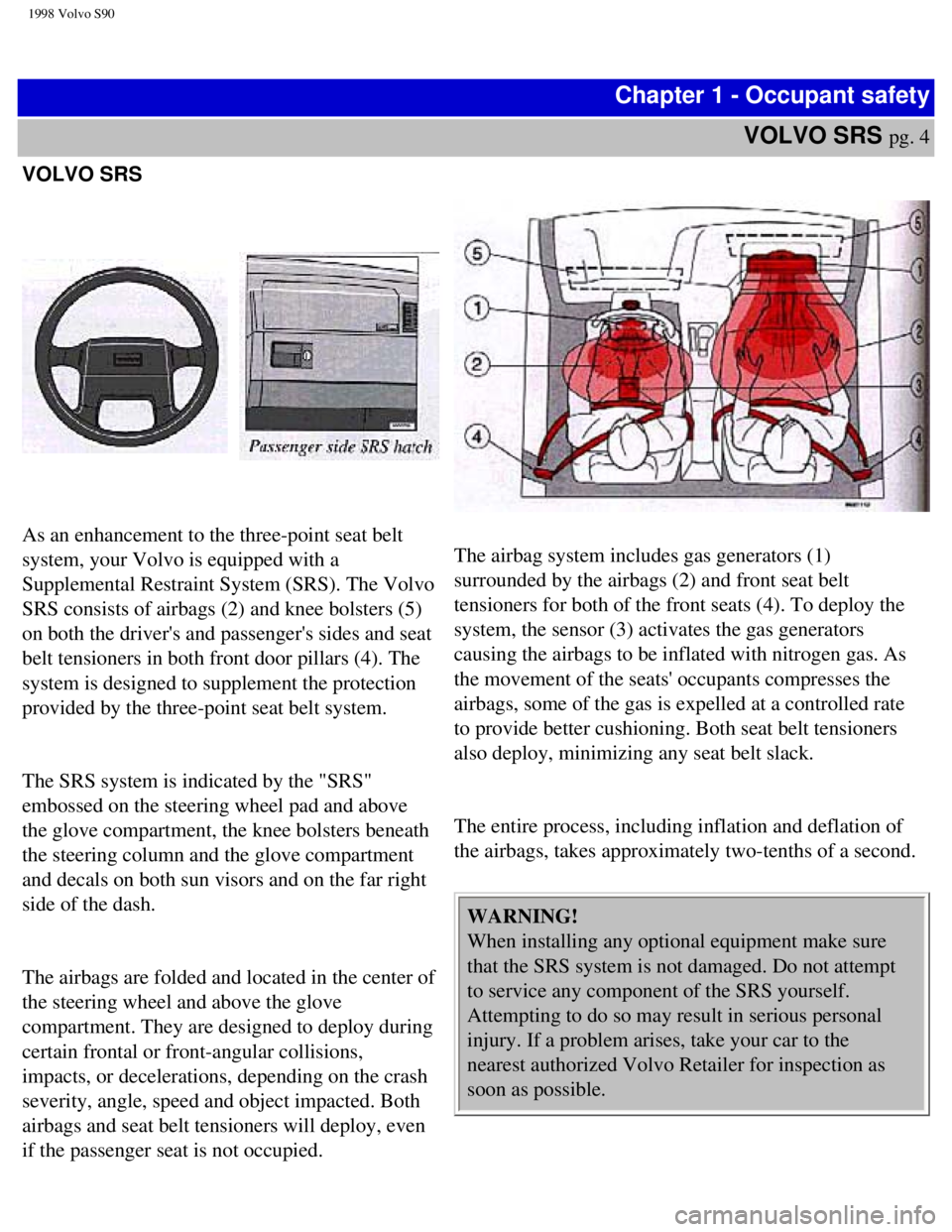
1998 Volvo S90
Chapter 1 - Occupant safety
VOLVO SRS
pg. 4
VOLVO SRS
As an enhancement to the three-point seat belt
system, your Volvo is equipped with a
Supplemental Restraint System (SRS). The Volvo
SRS consists of airbags (2) and knee bolsters (5)
on both the driver's and passenger's sides and seat
belt tensioners in both front door pillars (4). The
system is designed to supplement the protection
provided by the three-point seat belt system.
The SRS system is indicated by the "SRS"
embossed on the steering wheel pad and above
the glove compartment, the knee bolsters beneath
the steering column and the glove compartment
and decals on both sun visors and on the far right
side of the dash.
The airbags are folded and located in the center of
the steering wheel and above the glove
compartment. They are designed to deploy during
certain frontal or front-angular collisions,
impacts, or decelerations, depending on the crash
severity, angle, speed and object impacted. Both
airbags and seat belt tensioners will deploy, even
if the passenger seat is not occupied.
The airbag system includes gas generators (1)
surrounded by the airbags (2) and front seat belt
tensioners for both of the front seats (4). To deploy the
system, the sensor (3) activates the gas generators
causing the airbags to be inflated with nitrogen gas. As
the movement of the seats' occupants compresses the
airbags, some of the gas is expelled at a controlled rate
to provide better cushioning. Both seat belt tensioners
also deploy, minimizing any seat belt slack.
The entire process, including inflation and deflation of
the airbags, takes approximately two-tenths of a second.
WARNING!
When installing any optional equipment make sure
that the SRS system is not damaged. Do not attempt
to service any component of the SRS yourself.
Attempting to do so may result in serious personal
injury. If a problem arises, take your car to the
nearest authorized Volvo Retailer for inspection as
soon as possible.
file:///K|/ownersdocs/1998/1998_SV90/98S90_004.htm (1 of 7)12/30/2006 \
1:52:34 PM
Page 11 of 175
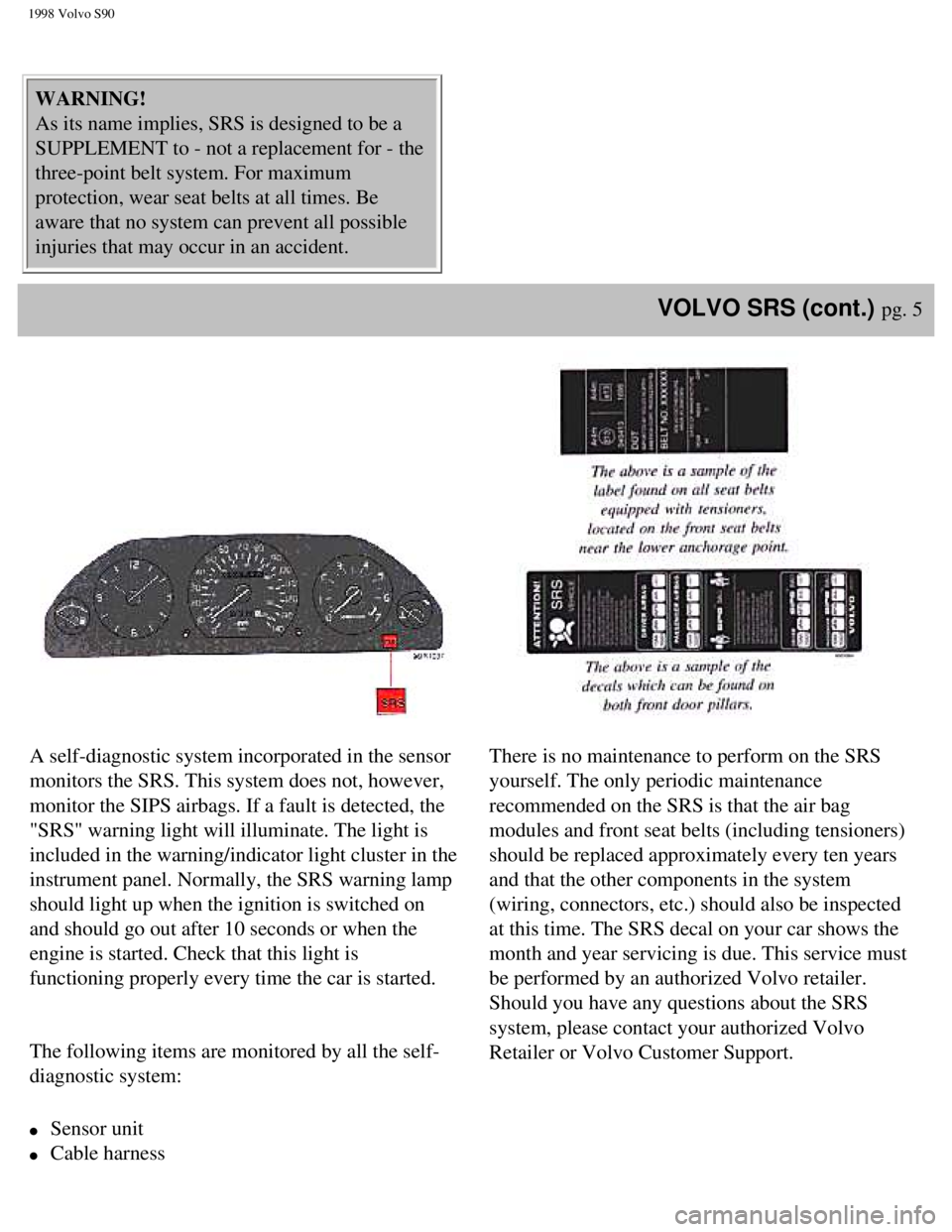
1998 Volvo S90
WARNING!
As its name implies, SRS is designed to be a
SUPPLEMENT to - not a replacement for - the
three-point belt system. For maximum
protection, wear seat belts at all times. Be
aware that no system can prevent all possible
injuries that may occur in an accident.
VOLVO SRS (cont.) pg. 5
A self-diagnostic system incorporated in the sensor
monitors the SRS. This system does not, however,
monitor the SIPS airbags. If a fault is detected, the
"SRS" warning light will illuminate. The light is
included in the warning/indicator light cluster in the
instrument panel. Normally, the SRS warning lamp
should light up when the ignition is switched on
and should go out after 10 seconds or when the
engine is started. Check that this light is
functioning properly every time the car is started.
The following items are monitored by all the self-
diagnostic system:
l Sensor unit
l Cable harness
There is no maintenance to perform on the SRS
yourself. The only periodic maintenance
recommended on the SRS is that the air bag
modules and front seat belts (including tensioners)
should be replaced approximately every ten years
and that the other components in the system
(wiring, connectors, etc.) should also be inspected
at this time. The SRS decal on your car shows the
month and year servicing is due. This service must
be performed by an authorized Volvo retailer.
Should you have any questions about the SRS
system, please contact your authorized Volvo
Retailer or Volvo Customer Support.
file:///K|/ownersdocs/1998/1998_SV90/98S90_004.htm (2 of 7)12/30/2006 \
1:52:34 PM
Page 13 of 175
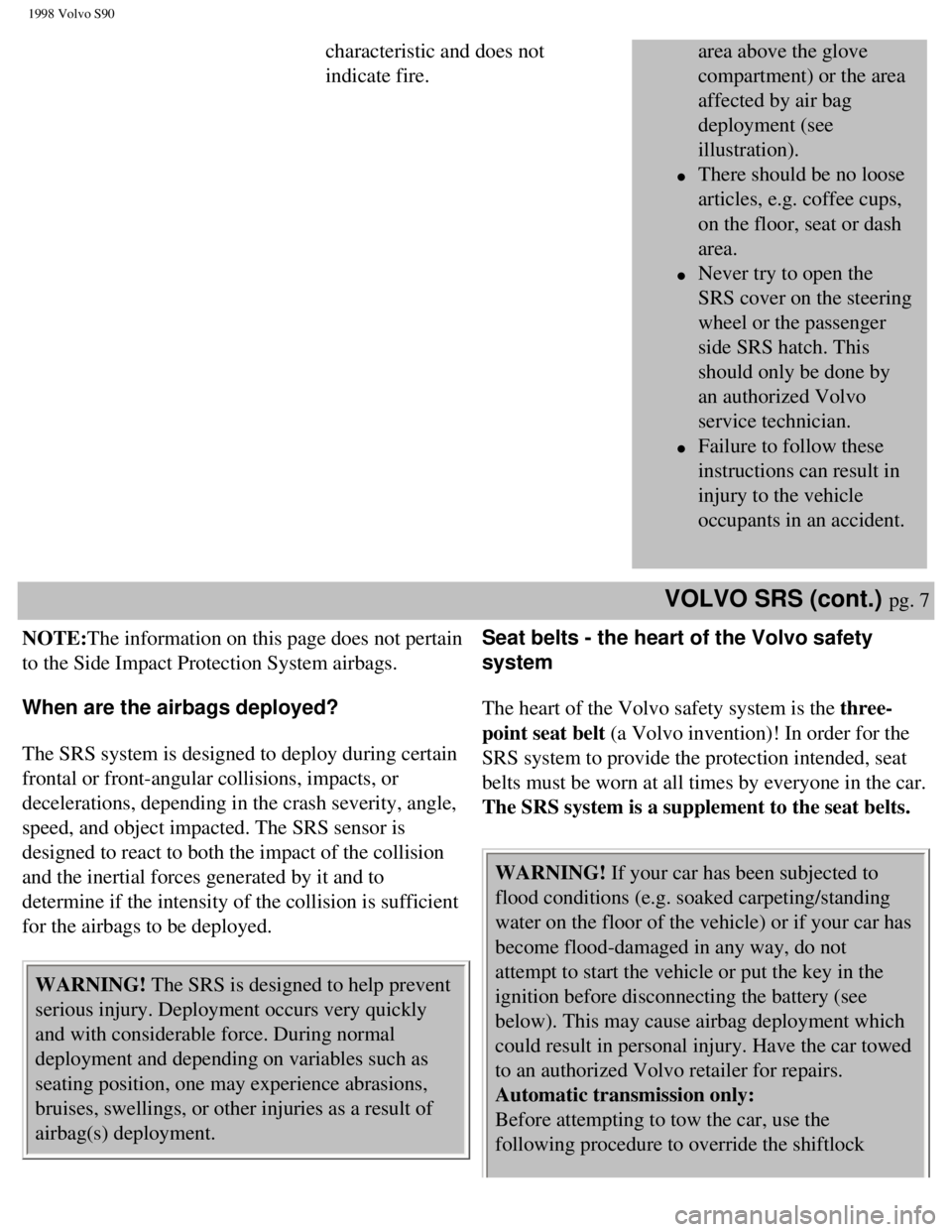
1998 Volvo S90
characteristic and does not
indicate fire. area above the glove
compartment) or the area
affected by air bag
deployment (see
illustration).
l There should be no loose
articles, e.g. coffee cups,
on the floor, seat or dash
area.
l Never try to open the
SRS cover on the steering
wheel or the passenger
side SRS hatch. This
should only be done by
an authorized Volvo
service technician.
l Failure to follow these
instructions can result in
injury to the vehicle
occupants in an accident.
VOLVO SRS (cont.) pg. 7
NOTE:The information on this page does not pertain
to the Side Impact Protection System airbags.
When are the airbags deployed?
The SRS system is designed to deploy during certain
frontal or front-angular collisions, impacts, or
decelerations, depending in the crash severity, angle,
speed, and object impacted. The SRS sensor is
designed to react to both the impact of the collision
and the inertial forces generated by it and to
determine if the intensity of the collision is sufficient
for the airbags to be deployed.
WARNING! The SRS is designed to help prevent
serious injury. Deployment occurs very quickly
and with considerable force. During normal
deployment and depending on variables such as
seating position, one may experience abrasions,
bruises, swellings, or other injuries as a result of
airbag(s) deployment.
Seat belts - the heart of the Volvo safety
system
The heart of the Volvo safety system is the three-
point seat belt (a Volvo invention)! In order for the
SRS system to provide the protection intended, seat
belts must be worn at all times by everyone in the car.
The SRS system is a supplement to the seat belts.
WARNING! If your car has been subjected to
flood conditions (e.g. soaked carpeting/standing
water on the floor of the vehicle) or if your car has
become flood-damaged in any way, do not
attempt to start the vehicle or put the key in the
ignition before disconnecting the battery (see
below). This may cause airbag deployment which
could result in personal injury. Have the car towed
to an authorized Volvo retailer for repairs.
Automatic transmission only:
Before attempting to tow the car, use the
following procedure to override the shiftlock
file:///K|/ownersdocs/1998/1998_SV90/98S90_004.htm (4 of 7)12/30/2006 \
1:52:34 PM
Page 14 of 175
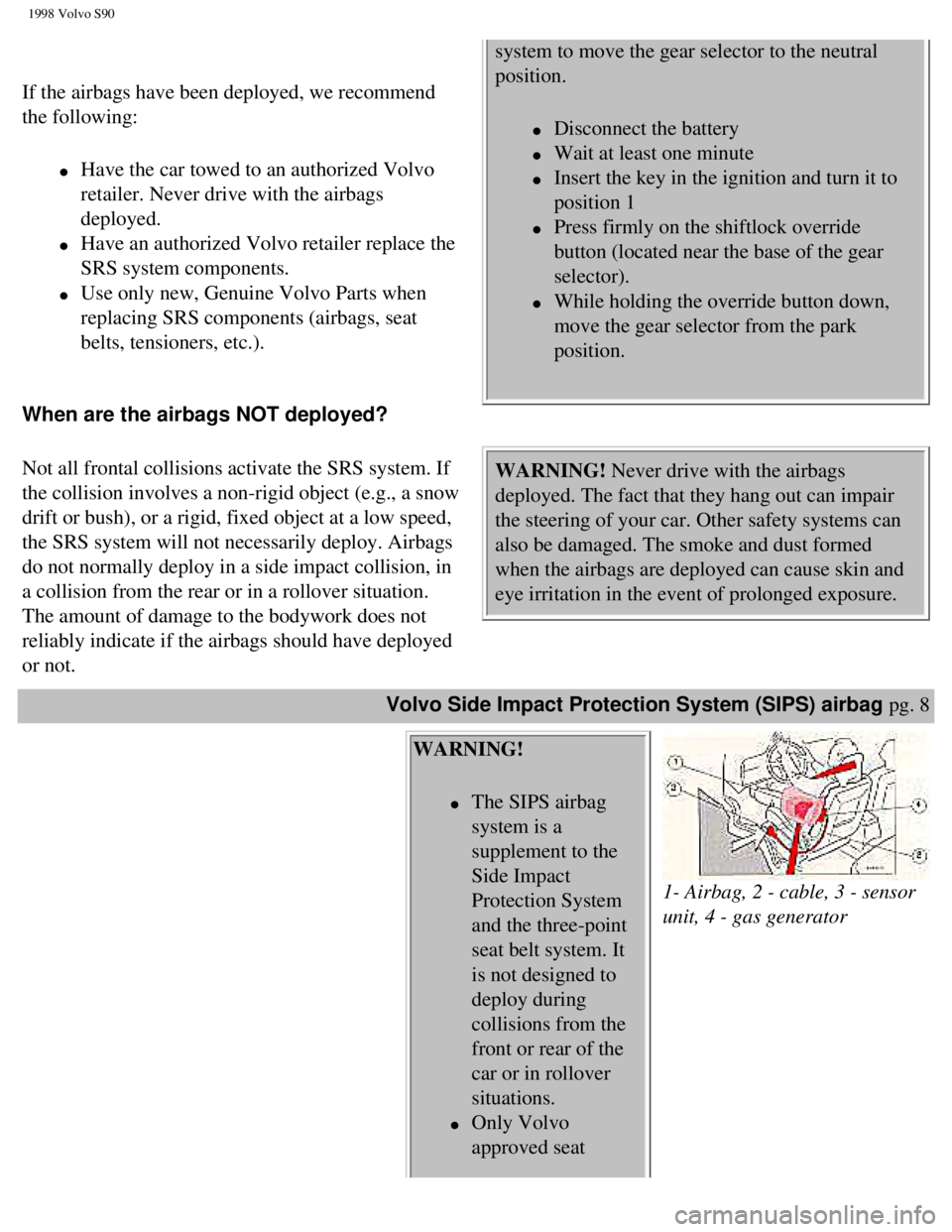
1998 Volvo S90
If the airbags have been deployed, we recommend
the following:
l Have the car towed to an authorized Volvo
retailer. Never drive with the airbags
deployed.
l Have an authorized Volvo retailer replace the
SRS system components.
l Use only new, Genuine Volvo Parts when
replacing SRS components (airbags, seat
belts, tensioners, etc.).
When are the airbags NOT deployed?
Not all frontal collisions activate the SRS system. If
the collision involves a non-rigid object (e.g., a snow
drift or bush), or a rigid, fixed object at a low speed,
the SRS system will not necessarily deploy. Airbags
do not normally deploy in a side impact collision, in
a collision from the rear or in a rollover situation.
The amount of damage to the bodywork does not
reliably indicate if the airbags should have deployed
or not.
system to move the gear selector to the neutral
position.
l Disconnect the battery
l Wait at least one minute
l Insert the key in the ignition and turn it to
position 1
l Press firmly on the shiftlock override
button (located near the base of the gear
selector).
l While holding the override button down,
move the gear selector from the park
position.
WARNING! Never drive with the airbags
deployed. The fact that they hang out can impair
the steering of your car. Other safety systems can
also be damaged. The smoke and dust formed
when the airbags are deployed can cause skin and
eye irritation in the event of prolonged exposure.
Volvo Side Impact Protection System (SIPS) airbag pg. 8
WARNING!
l The SIPS airbag
system is a
supplement to the
Side Impact
Protection System
and the three-point
seat belt system. It
is not designed to
deploy during
collisions from the
front or rear of the
car or in rollover
situations.
l Only Volvo
approved seat
1- Airbag, 2 - cable, 3 - sensor
unit, 4 - gas generator
file:///K|/ownersdocs/1998/1998_SV90/98S90_004.htm (5 of 7)12/30/2006 \
1:52:34 PM
Page 15 of 175
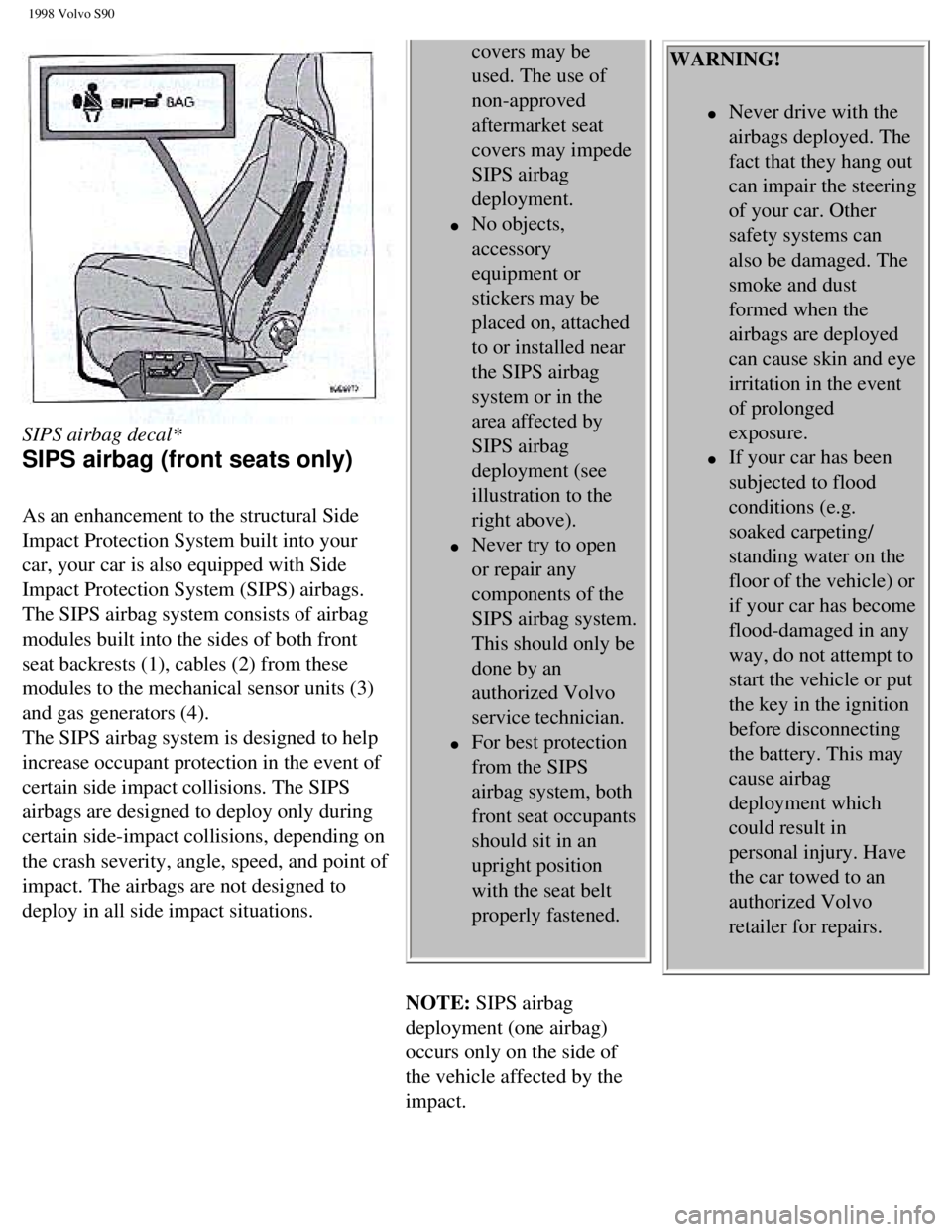
1998 Volvo S90
SIPS airbag decal*
SIPS airbag (front seats only)
As an enhancement to the structural Side
Impact Protection System built into your
car, your car is also equipped with Side
Impact Protection System (SIPS) airbags.
The SIPS airbag system consists of airbag
modules built into the sides of both front
seat backrests (1), cables (2) from these
modules to the mechanical sensor units (3)
and gas generators (4).
The SIPS airbag system is designed to help
increase occupant protection in the event of
certain side impact collisions. The SIPS
airbags are designed to deploy only during
certain side-impact collisions, depending on
the crash severity, angle, speed, and point of
impact. The airbags are not designed to
deploy in all side impact situations.
covers may be
used. The use of
non-approved
aftermarket seat
covers may impede
SIPS airbag
deployment.
l No objects,
accessory
equipment or
stickers may be
placed on, attached
to or installed near
the SIPS airbag
system or in the
area affected by
SIPS airbag
deployment (see
illustration to the
right above).
l Never try to open
or repair any
components of the
SIPS airbag system.
This should only be
done by an
authorized Volvo
service technician.
l For best protection
from the SIPS
airbag system, both
front seat occupants
should sit in an
upright position
with the seat belt
properly fastened.
NOTE: SIPS airbag
deployment (one airbag)
occurs only on the side of
the vehicle affected by the
impact.
WARNING!
l Never drive with the
airbags deployed. The
fact that they hang out
can impair the steering
of your car. Other
safety systems can
also be damaged. The
smoke and dust
formed when the
airbags are deployed
can cause skin and eye
irritation in the event
of prolonged
exposure.
l If your car has been
subjected to flood
conditions (e.g.
soaked carpeting/
standing water on the
floor of the vehicle) or
if your car has become
flood-damaged in any
way, do not attempt to
start the vehicle or put
the key in the ignition
before disconnecting
the battery. This may
cause airbag
deployment which
could result in
personal injury. Have
the car towed to an
authorized Volvo
retailer for repairs.
file:///K|/ownersdocs/1998/1998_SV90/98S90_004.htm (6 of 7)12/30/2006 \
1:52:34 PM
Page 27 of 175
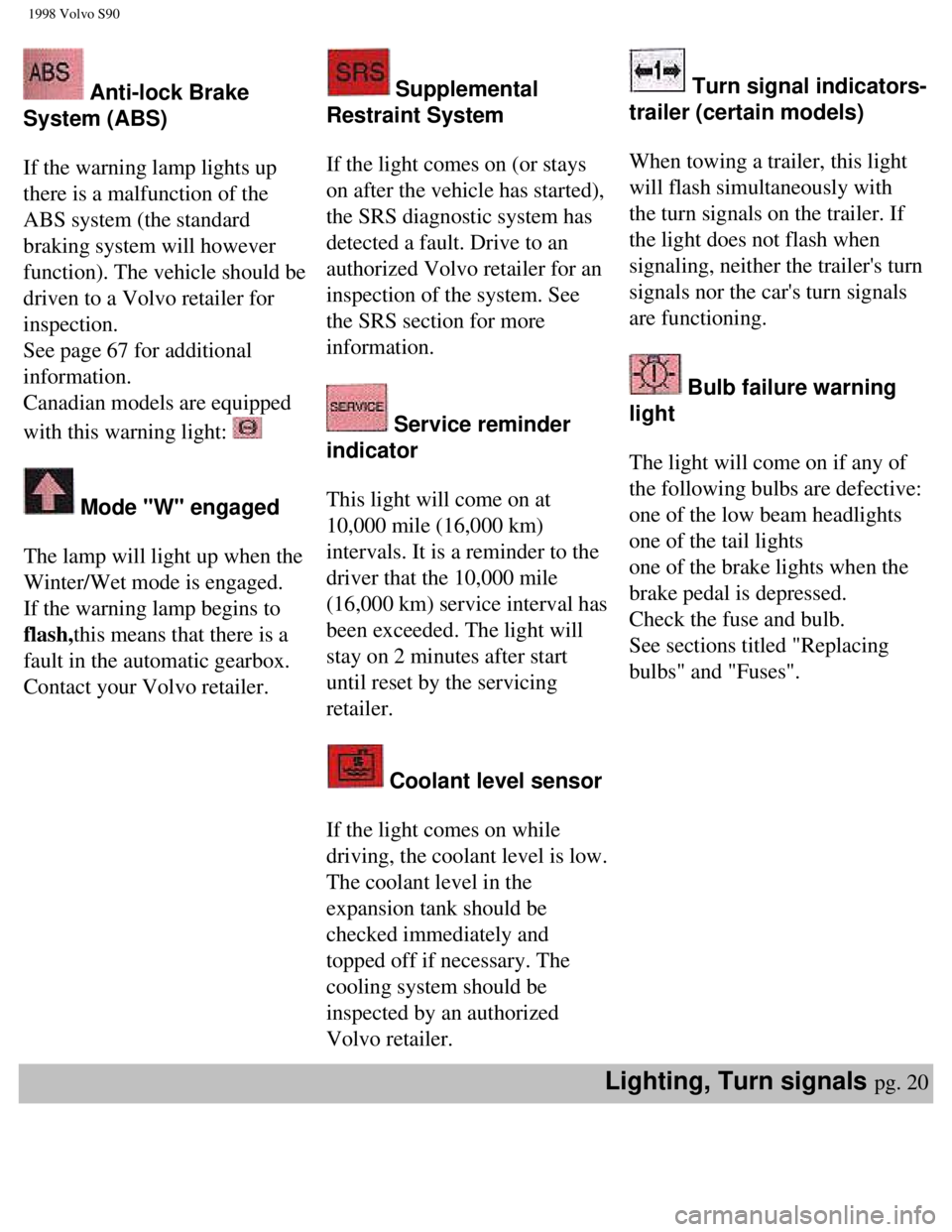
1998 Volvo S90
Anti-lock Brake
System (ABS)
If the warning lamp lights up
there is a malfunction of the
ABS system (the standard
braking system will however
function). The vehicle should be
driven to a Volvo retailer for
inspection.
See page 67 for additional
information.
Canadian models are equipped
with this warning light:
Mode "W" engaged
The lamp will light up when the
Winter/Wet mode is engaged.
If the warning lamp begins to
flash,this means that there is a
fault in the automatic gearbox.
Contact your Volvo retailer.
Supplemental
Restraint System
If the light comes on (or stays
on after the vehicle has started),
the SRS diagnostic system has
detected a fault. Drive to an
authorized Volvo retailer for an
inspection of the system. See
the SRS section for more
information.
Service reminder
indicator
This light will come on at
10,000 mile (16,000 km)
intervals. It is a reminder to the
driver that the 10,000 mile
(16,000 km) service interval has
been exceeded. The light will
stay on 2 minutes after start
until reset by the servicing
retailer.
Coolant level sensor
If the light comes on while
driving, the coolant level is low.
The coolant level in the
expansion tank should be
checked immediately and
topped off if necessary. The
cooling system should be
inspected by an authorized
Volvo retailer.
Turn signal indicators-
trailer (certain models)
When towing a trailer, this light
will flash simultaneously with
the turn signals on the trailer. If
the light does not flash when
signaling, neither the trailer's turn
signals nor the car's turn signals
are functioning.
Bulb failure warning
light
The light will come on if any of
the following bulbs are defective:
one of the low beam headlights
one of the tail lights
one of the brake lights when the
brake pedal is depressed.
Check the fuse and bulb.
See sections titled "Replacing
bulbs" and "Fuses".
Lighting, Turn signals pg. 20
file:///K|/ownersdocs/1998/1998_SV90/98S90_017.htm (3 of 7)12/30/2006 \
1:52:36 PM
Page 35 of 175

1998 Volvo S90
lock, the cruise control will
disengage automatically.
Heating, ventilation and air conditioning pg. 25
ECC - Electronic Climate Control
This is an automatic system that also permits
manual operation. The in-car temperature is
automatically monitored by two sensors located in
the passenger compartment.
One sensor is located on the top of the dashboard
where it can sense sunlight. The second sensor is
located on the courtesy light fixture where it can
sense the temperature in the center of the car. The
following pages describe how ECC works and
how it can be used most effectively.
Refrigerant
Volvo cares about the environment. The air
conditioning system in your car contains a CFC-
free refrigerant - R134a. This substance will not
deplete the ozone layer. The system contains 2 lbs
(0.9 kg) R134a and uses Sanden SP-20 (type
PAG) oil.
Air vents (dash)
A Open
B Closed
C Directing air flow horizontally
D Directing air flow vertically
NOTE:All maintenance on the climate control
systems should be carried out by an authorized
Volvo service technician only.
Heating, ventilation and air conditioning (cont.) pg. 26
file:///K|/ownersdocs/1998/1998_SV90/98S90_023.htm (4 of 7)12/30/2006 \
1:52:37 PM
Page 38 of 175

1998 Volvo S90
heating positions.
Water under the vehicle in hot weather
can be the result of condensation from
the air conditioning system.
Optimum defrosting
Set the function dial to
.
The air conditioning light will NOT go
on.
When the windows have cleared, set the
blower control to position 2.
conditions, heavy rain, sleet,
etc., it may be better to use
the manual rather than the
automatic setting to defrost
the windows. Set the mode
selector to "Defrost" or
"Defrost/floor" and the fan
speed to 3 or higher. Also
shut the middle air vents. NOTE:
l Do not place any
objects over the
sensor in the
passenger side
speaker grille as
this will cause the
ECC system to
respond incorrectly
to ambient
conditions.
l To help maintain
stable passenger
compartment
temperature when
driving with the sun
roof or windows
open, place the
blower control in
position "0" and
adjust the desired
temperature
manually.
l The air
conditioning
compressor only
engages at
temperatures above
41°F (5°C).
l Always keep the air
intake grille at the
base of the
windshield free of
snow.
Contents | Top of Page
file:///K|/ownersdocs/1998/1998_SV90/98S90_023.htm (7 of 7)12/30/2006 \
1:52:37 PM
Page 61 of 175

1998 Volvo S90
A new car should be broken-in!
Refrain from utilizing your car's full driving
potential, e.g. full-throttle acceleration, during the
first 1,200 miles (2,000 km).
Automatic transmission
Do not use "kick-down" during the first 1,200
miles (2,000 km).
NOTE - ENGINE OIL:
Although some oil consumption during normal
engine operation, more oil is consumed when the
engine is new as the internal parts generate higher
friction while wearing-in to each other. From the
time the engine is new until the first service is
performed, the oil consumption could be
higher than normal. For this reason, it is
especially important to check the oil every time
you refuel your car during this period. See
page 108.
In general, the rate of oil consumption depends on
such factors as: engine temperature, length of trip,
driving conditions, oil viscosity and quality,
engine speed and acceleration/deceleration.
Checking your engine oil level each time the car
is refuelled is one of the most important items
you can perform to help keep your car in good
running order.
Deposit control gasoline (detergent
additives)
Volvo recommends the use of gasoline containing
deposit control additives. These additives have
shown to be efficient in keeping injectors and
intake valves clean. Consistent use of deposit
control gasolines will help ensure good
driveability and fuel economy. If you are not sure
whether the gasoline contains deposit control
additives, check with the service station operator.
Unleaded Fuel
Each Volvo has a three-way catalytic converter
and must use only unleaded gasoline. U.S. and
Canadian regulations require that pumps
delivering unleaded gasoline be labeled
"UNLEADED". Only these pumps have nozzles
which fit your car's filler inlet. It is unlawful to
dispense leaded fuel into a vehicle labeled
"unleaded gasoline only". Leaded gasoline
damages the three-way catalytic converter and the
heated oxygen sensor system. Repeated use of
leaded gasoline will lessen the effectiveness of
the emission control system and could result in
loss of emission warranty coverage. State and
local vehicle inspection programs will make
detection of misfueling easier, possibly resulting
in emission test failure for misfueled vehicles.
NOTE: Some U.S. and Canadian gasolines
contain an octane enhancing additive called
methyl-cyclopentadienyl manganese tricarbonyl
(MMT). If such fuels are used, your Emission
Control System performance may be affected,
and the Malfunction Indicator Lamp located on
your instrument panel may light. If this occurs,
please return your vehicle to an authorized Volvo
retailer for service.
file:///K|/ownersdocs/1998/1998_SV90/98S90_053.htm (2 of 6)12/30/2006 \
1:52:41 PM